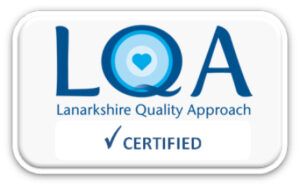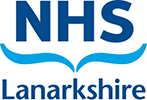Balloon Gastronomy
Information for patients
NHS Lanarkshire Nutrition and Dietetic Department
PIL.BALGAS.0011.L
Gastrostomy Feeding
You are currently unable to take enough food and fluid by mouth to meet your nutritional needs or you may be unable to take any food or fluids by mouth at all. The gastrostomy feeding tube will help you to meet your nutritional needs by feeding you directly into your stomach.
Gastrostomy tubes are used for longer term feeding; lasting more than four to six weeks.
Balloon retained gastrostomy tube
- Balloon Gastrostomy tubes can be used to replace the initial PEG tube or may be a primary tube.
- A water filled balloon holds the tube in place in your stomach.
- The amount of water in the balloon should be checked weekly. Your district nurse will do this for you or if you prefer you or your carer may be trained to do this.
- The balloon valve will have the amount of water required written on it.
- Use cooled boiled water to fill the balloon.
- Whenever the balloon is checked or your tube is replaced it is important to check the tube is still in your stomach. This can be done by drawing out a small amount of stomach contents and testing this with pH paper. Your district nurse may do this or train you or your carers how to do this.
- A pH of 5.5 or below indicates the tube is in your stomach.
- You should have been given a spare feeding tube, please keep this to hand for the person coming to the house to replace the tube or take it with you if you have been advised to attend hospital to get your tube replaced. If you do not have a spare tube please let your health professional know.
- These gastrostomy tubes can last between three to six months.
- In preparation for the tube replacement you should remain nil by gastrostomy/nil by mouth. This means no feed for four hours and no fluids for two hours before the tube replacement takes place.
Stop feeding and contact your Healthcare professional immediately if:
- There is pain on feeding
- External leakage of gastric contents
- Fresh bleeding
Care of Your Gastrostomy Tube and Stoma
Effective care of your tube and stoma are vital for your well-being. The aim is to prevent your tube blocking, maintain a healthy stoma site and to prevent infection and breakdown of the surrounding skin.
Wash your hands thoroughly before and after handling the feeding system.
- Clean your stoma with mild soap and water, rinse and dry thoroughly.
- Loosening and rotating the gastrostomy tube 360 degrees (a full turn) daily helps prevent the build up of scar tissue.
- Flush the tube regularly with cooled boiled water before and after the administration of feed to help prevent your tube blocking.
- If you give medication down your tube it must preferably be in a liquid or dispersible form, please discuss this with your pharmacist. Always remember to flush your tube before and after medication with 30-60 mls of cooled boiled water.
- If several medications are going down the tube, flush with at least 5-10mls cooled boiled water between each medication.
If your tube becomes blocked see troubleshooting guide.
Trouble Shooting Guide
| Problem | Possible Cause | Solution |
|
Tube will not flush. |
|
If all of the above are unsuccessful contact your feeding company nurse or health professional. |
|
GI problems e.g. nausea and vomiting Diahorrea. Constipation. |
|
|
|
Gastric Reflux |
|
|
|
If feeding tube comes out or dislodged. |
Contact your health professional to arrange for readmission to have tube re-inserted. |
Instructions on using your syringe
- The syringes you have been given can be reused for up to seven days.
- Clean your syringe straight after use
- Fill a bowl with hot soapy water
- Clean the end of the syringe by drawing the water in and out through the syringe until all traces of food or medicine are removed from the tip.
- Separate the two parts of the syringe and wash them.
- Then rinse them in water under the cold tap.
- Shake off the excess water and dry with a clean paper towel. Tapping the end of the syringe on a clean paper towel will dislodge any water that maybe still in the tip of the syringe.
- Store the syringe, still separated in a clean dry container.
- Put the syringe back together when you need to use it.
- You will usually be given one syringe for medicine and one for flushing cooled boiled water through your tube.
- If while you are using your syringe it becomes stiff or difficult to use, or if you can see any damage to the syringe or the markings become unclear you should throw it away and start to use a new one.
- If you use an extension set this can be reused for two weeks. Wash and store it in the same way as your syringes.
Further Information
You should be referred to see the diabetes dietitian for further information and individual advice.
Pub. date: June 2020
Review date: June 2022
Issue No: 02
Reference: PIL.BALGAS.0011.L
21_06017
If you need this information in another language or format, please e-mail:





